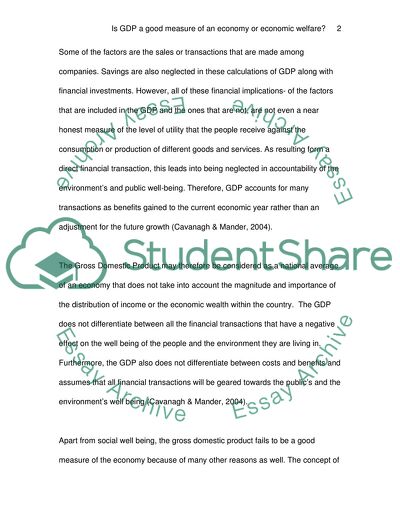
- Home
- Free Samples
- Premium Essays
- Editing Services
- Extra Tools
- Essay Writing Help
- About Us
- Studentshare
- Subjects
- Miscellaneous
- Macroeconomics
Macroeconomics - Essay Example

- Subject: Miscellaneous
- Type: Essay
- Level: Masters
- Pages: 4 (1000 words)
- Downloads: 0
- Author: fschuppe
Extract of sample "Macroeconomics"
The expenditure method of calculating GDP assess the financial value of the total expenditure of the government and the people on finished goods and services. Moreover, expenditures in the form of investments in industries and equipment, and the net exports of a country are also included in the evaluation of GDP. As the GDP accounts for only the final goods and services produced within the economy, it ignores many other economic transactions and factors that are important in measuring economic welfare for a country (Bauhmol, 2007).
Some of the factors are the sales or transactions that are made among companies. Savings are also neglected in these calculations of GDP along with financial investments. However, all of these financial implications- of the factors that are included in the GDP and the ones that are not, are not even a near honest measure of the level of utility that the people receive against the consumption or production of different goods and services. As resulting form a direct financial transaction, this leads into being neglected in accountability of the environment’s and public well-being.
Therefore, GDP accounts for many transactions as benefits gained to the current economic year rather than an adjustment for the future growth (Cavanagh & Mander, 2004). The Gross Domestic Product may therefore be considered as a national average of an economy that does not take into account the magnitude and importance of the distribution of income or the economic wealth within the country. The GDP does not differentiate between all the financial transactions that have a negative effect on the well being of the people and the environment they are living in.
Furthermore, the GDP also does not differentiate between costs and benefits and assumes that all financial transactions will be geared towards the public’s and the environment’s well being (Cavanagh & Mander, 2004). Apart from social well being, the gross domestic product fails to
...Download file to see next pages Read MoreCHECK THESE SAMPLES OF Macroeconomics
INTERMEDIATE MACROECONOMICS
Intermediate Macroeconomics
Macroeconomics Theory
Keynesian macroeconomics
Applied Macroeconomics
Intermediate macroeconomics
Pfizer Macroeconomics
Macroeconomics Theory

- TERMS & CONDITIONS
- PRIVACY POLICY
- COOKIES POLICY